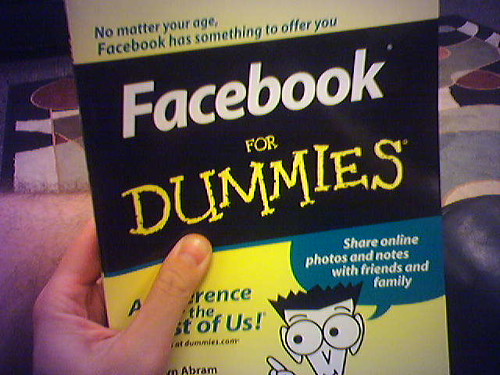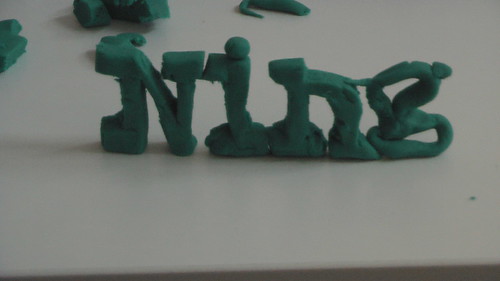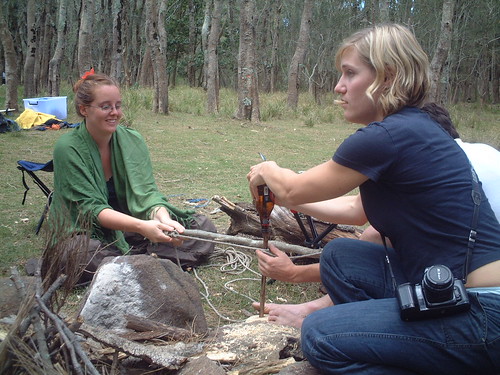 |
| fdecomite's flickr photostream |
Of course the transparency in assessment has been around for a while. We have been creating rubrics and descriptions of assessment "for", "of" and "as" learning in attempts to clearly communicate our expectations to students, parents and even for teachers when planning using Understanding by Design principles. The transparency allows us to more clearly identify the path of learning necessary to achieve our goals, in this case curriculum outcomes.
So what does transparency in social networking look like? I believe there are a few ways to answer this. Firstly, there is the transparency of our digital footprint. Everything we publish to the web becomes accessible by others. As well, everything others publish about us is also accessible by others. Even if we have the "private" settings, once something is published, it is out of our hands and susceptible to whomever happens to come across it. Secondly, there is the transparency of the learning which others have chosen to share via the Internet in many forms (Trailfires, podcasts, videos, blogs, microblogging, wikis, etc.). Finally, and perhaps not as frequently, there is the transparency of the practices of teachers educating students in how to use these social networking resources. As Will Richardson (2010) indicates, "we must be able to model for students our own connections outside of the physical spaces we inhabit, and we also must demonstrate our passion for learning transparently in our practice. We must become, in essence, network literate" (Bellanca & Brandt, p. 296).
 |
| fdecomite's flickr photostream |
Media educators are beginning to consider this new media ecology's potential to reshape the conditions under which young people engage with media and culture, moving youth from positions as media consumers to more active media producers. In what Henry Jenkins (2006) and his colleagues have described as "participatory culture," budding creators can develop their voices and identities as media creators through ongoing interaction with engaged peers and audiences (Ito et al., 2010)
 |
| Joe Shlabotnik's flickr photostream |
For anyone who has not experienced these passion-based learning connections, it is difficult to fully understand the pedagogical implications for curricula and classrooms. To be sure, at this moment, tens of thousands of teachers and no doubt hundreds of thousands of students around the world are employing social networking tools such as blogs and wikis in their classrooms. But close inspection of those implementations shows that the vast majority are little more than taking what has been done for years and years in the paper, analog curriculum and repurposing it into a digital format. In essence, we replaced a pen with a blog, and very rarely did the pedagogies change in the process. Why? Because the teachers leading those efforts are not networked learners themselves, ones who understand that the full potential of these tools is found not in the publishing of information, but rather in the resulting connections (Bellanca & Brandt, p. 297)In regards to safety, Berger & Trexler (2010, p. 175) display a list from Safety Tips for Tweens and Teens, which is a compilation of advice from various safety organizations (see my side bar for a list of some of these organizations):
Teach children to:
- Never give out personal information such as name, school, address, phone number, email address, or photos of themselves. Once such information is placed online, it can never be taken back.
- Never make arrangements to meet in person someone that they've met online, without parental permission or without a trusted adult present at the meeting.
- Never post pictures of themselves or e-mail or send attachments of such photos to anyone without parental approval. Never should they be sent to strangers.
- Never include hints as to their real identity; use screen names that are nondescript.
- Never open attachments, Web sites, or URLs sent to them by strangers. They could contain viruses or inappropriate viewing material.
- Obey the age requirements posted by Web sites in their terms of service statement. Age restrictions are in place as a safety precaution.
- Know that they control who sees their information when they use the privacy settings offered by Web sites. They should use the setting that requires approval before accepting anyone as a friend.
- Never post anything about themselves of others that they wouldn't want their parents or teachers to see. That includes bad language or antagonistic remarks about other people or classmates. Neither should they respond to provoking remarks directed to them made by others. Such incidents should be reported to trusted adults.
- Never buy things online or enter online contests without parental approval. Personal information is usually required for such activities and should not ever be shared.
- Get parental approval before an account is created. Parents should keep a master log of all such accounts, as well as the user IDs and passwords.
- If students encounter offensive or dangerous material online, don't play the blame game. Use the opportunity to teach them to turn off the monitor and report the incident immediately to a trusted adult, so it can be reported to the authorities. Follow up with open discussion about safety concerns
- WTGP - Want to go private
- POS - Parent over shoulder
- PIR - Parent in room
- PAW - Parents are watching
- PAL - Parents are listening
- LMIRL - Let's meet in real life
- IRL - In real life
- F2F - Face to face
- ASL - Age, sex, location
It is also worthwhile to research settings on various social networking sites we participate in. As Richardson indicates, Facebook offers a number of different levels of transparency that you might want to explore, and they are covered in great detail in the "Teacher's Guide to Using Facebook" by Bernadette Rego. Another example, the YouTube video - Beyond Facebook's New Simplified Privacy Settings gives a great overview of what each setting on Facebook means, how to adjust them, and what information will and won't show depending on the settings you choose.
Another interesting YouTube video to watch is How To Set Up a MySpace Profile. This is a great description of how a profile is set up, and information contained is sometimes forth-coming, and other times is quite misleading. It is interesting how both the friendship and interest driven aspects are both part of this networking site. I do not have a MySpace account, however, it does have some networking and blogging features I am interested in which are not available on Facebook.
Berger & Trexler note that the American Association of School Librarians (AASL) identify that "learning has a social context" and this social context occurs whether they are face-to-face settings or online. In that vein, Berger & Trexler identify Twelve Reasons to Use Social Networking (p. 164):
- Creates real-life friendships through similar interests or groups.
- Enhances technology and communication skills.
- Promotes creativity.
- Presents new or diverse views.
- Provides practice editing/customizing content.
- Shares creative work.
- Supports user's need to affiliate.
- Offers opportunity to practice safe, ethical, and responsible use.
- Creates an environment that fosters participation in online communities.
- Expands/creates friendships.
- Encourages user-generated content - videos and photos.
- Allows educators to reach students through a medium they use every day.
 |
| daveynin's flickr photostream |
Facebook has also been a great place for planning. Many of my friends use Facebook to organize events, clubs and other groups. We have used the site to organize attendance and fundraisers for ringette; an annual Santa's Anonymous Christmas Party fundraiser; Biggest Loser weight loss challenges; Winter Friday Night's Poker Club; and many other sales party events. Recently, a friend of mine from high school lost her daughter due to a birth defect they were unaware of. Her daughter was only six years old and it was very sudden. Facebook became the sight where we supported her - people who would not have known or perhaps been able to extend their sympathies without the social network. Beyond that, it became a place where we joined our efforts to purchase spices from her Epicure business to help her earn the promotional free trip for her and her son. One friend made the suggestion in a post to all members of her Facebook community, and then these members forwarded the request to their Facebook communities, etc., enabling it to spread extensively throughout the Facebook network and beyond into the local community. It was a very successful way to support her.
I have friends who have used the site to advertise items or property they have for sale. Another friend shares coupons she finds for great bargains. And of course, we share the traditional media, such as pictures and videos.
Beyond Facebook, I revisited a Ning I had created an account for at the beginning of this course. My 30-day free trial had long ago run out and I am in the position of choosing to eliminate the Ning or pay a subscription fee. I wasn't interested in the fee, so I chose to leave it sit there, inactive and far from networked. However, I did take the opportunity to search the Ning community to see what was out there (just click on Search Ning Networks on the homepage).
 |
| fczuardi's flickr photostream |
I also looked for a Ning on photography. There are many to choose from. One of the first photography Nings I tried to join wouldn't let me...it was "currently unavailable". I could send a message with a comment or a question to the Ning creators, if I wanted.
 |
| one thousand years' flickr photostream |
I briefly explored the social network for personal interests. Bellanca & Brandt give an example of Nelson Smith, a 12 year old boy who used social networking with other bushmen to help him figure out why his method to start a fire using basic items wasn't working (p. 285). I have used social networking sites similarly to figure out how to fix things that weren't working on my computer (particularly Windows 7 - which is now not letting me send web clips to Evernote from Internet Explorer, but I have discovered that I can when using Mozilla Firefox). I have read through other people's comments and learned from their online, transparent conversations. However, I am guilty of lurking and not really contributing to these types of discussions.
In an educational setting, however, I have contributed. I have been participating in Twitter, which I will go into more depth in a future blog. I have shared links to articles I find useful, retweeted informative tweets and searched for tweets relevant to professional and personal interests. I have been following Classroom 2.0 even though I have yet to participate in it. I haven't participated yet not because I am hesitant to, but rather because I haven't had the time to.
Steven Hargadon has compiled an extensive listing of social networking sites which are being used for educational purposes on his blog Infinite Thinking Machine. He posted this list January of 2008, indicating it is only a snapshot of sites he found educationally useful at that time and this list will continue to evolve.
Berger & Trexler (2010) summarize some of the ways educators are using Ning (p. 166):
- Organize research projects
- Support group projects
- Serve as an online classroom
- Showcase student work (involving parents)
- Provide an informative site based on curriculum content
Further, they suggest to educators Three Strategies to Use Social Networks (2010, p. 173):
- Create classroom guidelines for the Ning with students; be sure they comply with district policy.
- Create a classroom or library social network. Invite students and encourage them to participate.
- Discuss the privacy settings on popular social networking Web sites with students and teach them how to apply them.
I have found a few Nings which fit well with my teaching assignment this year. The first Ning I found is No Time To Cook. It is a site which has recipes, cooking videos and a network to support the program I am trying to create for my Foods 8 course.
Another site I found is the English Companion: Where English teachers go to help each other. Within this network, I was able to find three other groups which are of interest to me. These groups are: Writing Prompts & Assignments, Literature Circles, and Poetry Corner. Each of these sites provides a network of educators asking questions, giving feedback, and providing valuable information which provides me with relevant professional development tailor made for my needs.
One last site I explored and am awaiting to hear if my request to join the Ning is approved (not all Nings are open to the public, and some require approval before you can join) is the Pearson Ning - I Teach Social Studies. Pearson is one of the resources I am using in my classroom and I quite like it. It supports Inquiry Based Learning and Historical Thinking Concepts, two areas I have been working to incorporate into my teaching.
Where do I have to go from here? I need to start participating in a discussion on a social network based on interests rather than friendships. I also need to dig further into setting up a social network, because I can see how this tool will fit better for some of the collaboration I want to do professionally.
My understanding of social networking has grown immensely. Facebook and MySpace had been prominent in creating a specific understanding of what social networking looked like for me. However, becoming fully immersed in the interest-driven social networking brings a new awareness to the arena. The transparent global classroom can provide us with educational opportunities which really have unlimited potential, both within and beyond the classroom walls.
References
Bellanca, J., & Brandt, R. (2010). 21st century skills: Rethinking how students learn. Bloomington, IN: Solution Tree.
Berger, P., & Trexler, S. (2010). Choosing web 2.0 tools for learning and teaching in a digital world. Santa Barbara, CA: Libraries Unlimited.
Ito, M., Baumer, S., Bittanti, M., boyd, d., Cody, R., Herr-Stephanson, B., . . . Tripp, L.(2010). Hanging out, messing around, and geeking out: Kids living and learning. Cambridge, MA: The MIT Press.
Richardson, W. (2010). Blogs, wikis, podcasts and other powerful web tools for classrooms. Thousand Oaks, CA: Corwin.






No comments:
Post a Comment